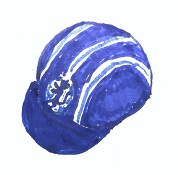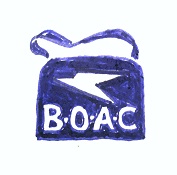Apart from a short 10-shilling joy-ride around Shoreham airport with my mother in 1949, my first proper flight was in 1952 to visit my parents who now lived in India. I was well briefed for this trip having read "Fly with the Pilot" by Alan Buck (1948) and I also enjoyed making rubber-powered model aeroplanes so I knew all about rudders, elevators, ailerons and Handley Page slots. I was aviation crazy!
I flew to India on a Canadair Argonaut powered by four Rolls Royce Merlin Engines, 1725 HP with 12 cylinders - a similar engine to the Supermarine Spitfire, Hawker Hurricane and P 15 Mustang: 48 cylinders in all. If one cylinder was misfiring this was called "engine trouble". It was not uncommon and it caused a delay at the next port-of-call while it was fixed by local mechanics, supervised by the engineer. At night the 6 exhaust ports of the inboard V12 engines could be seen glowing red-hot in the darkness. Passengers were reassured that this was perfectly normal. The exhausts were powerful enough to produce a small, but mesurable, amount of extra thrust in addition to the propellers. They were loud, like a motorbike, and there was a lot of vibration.
BOAC Flight 768 (960) Argonaut| Day 1 | 22.48 dep Air terminal (Victoria London) |
| 23.59 dep London Airport (Heathrow) | |
| Day 2 | 04.05 arr. Rome |
| 05.05 dep | |
| 11.45 arr. Cairo | |
| 12.45 dep. | |
| 20.05 arr. Bahrain | |
| 21.05 dep. | |
| Day 3 | 03.25 arr. Karachi |
| 05.25 dep. | |
| 08.10 arr. Bombay (Mumbai) |
The plane continued to Delhi, Calcutta, Rangoon, Singapore, Hong Kong, Tokyo.
The aircrew: pilot, co-pilot, engineer, and radio operator/navigator, were all former RAF-types, WW II vintage, but now being properly paid for what they enjoyed doing most: sporty and extremely friendly. They chatted happily with their fans, myself included, and were glad to tell us how it all worked. The navigator explained all about radio beacons and, should that fail, he showed me that there was also an observation bubble, just behind the bridge, where he could take a bearing on the sun or stars with a sextant. In later years, when I was a bit older, I was invited to sit in the co-pilot's seat and fly the plane for a few minutes myself. During the numerous stop-overs the crew ate at the same tables as the passengers and I remember being told by a pilot in Bahrain that, in these tropical latitudes, he always sprinkled salt on his sandwiches. I also noticed that the runways and hard-stands in the Middle East were made of wartime interlocking strips of profiled and perforated steel sheet: Marston Mat, a pre-war US invention.
From Bombay I boarded an Air India Douglas DC-3: smaller, 2 engines, and flying much lower through a lot of bumpy thermals with a drop into an "air pocket" over every stretch of non-convecting rice fields. First stop was Hyderabad and then on to Bangalore. There I was met by my father and we were driven to the Kolar Gold Fields, some 50 miles to the west by Bakinatham, my father's driver.
On one of these yearly trips, during my 2-hour stopover in Karachi, I lost my school cap: dark blue with three blue-white ribbons arranged like the stripes of a badger. It was found and auctioned as "lost property". Lost? Not really: it had my name sewn into it with a Cash's name-tape and they had our address. My father was invited to bid for it. He declined. I indulge the fantasy that it is now a treasured childhood memento owned by a Pakistani gentleman of about my age, who had been given it by his parents - too small to fit anyone older.

On my return to England, in the late evening, in January, a couple of months later, I took a taxi from the London-Victoria Air Terminal. I remember that, on arrival at my aunt's house in London, the taxi driver refused to accept a tip from this unseasonably sun-tanned 11-year-old brat flashing its BOAC overnight bag.

In 1954 I flew on a brand-new De Havilland DH 106 Comet 1, the world's first jet airliner!
No more chatting with the crew but it was much faster and much quieter and there was no vibration at all. However this first version was withdrawn from service after three of them disintegrated mysteriously in mid-air. The first crash was thought to have been a terrorist bomb but then two more followed. A surviving plane was tested to destruction in a water tank. The problem was a previously little-known phenomenon: "metal fatigue". The repeated pressurisation of the cabin, required for each of these new, high-altitude flights, had weakened the skin and structure of the aircraft. Apparently, there is no truth in the story that the cracks originated as stress concentrations at the corners of the square windows. However, later versions not only had a thicker skin, they also had rounded windows - like all other modern airliners. These later Comet versions were very successful and the Comet 4 series continued in service until 1981.
